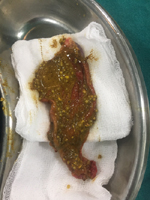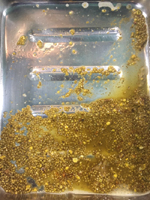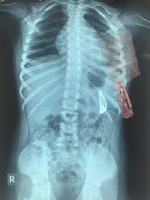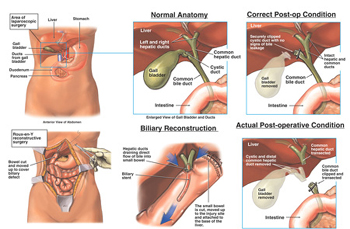
The gallbladder is a small pouch lying in the top part of the right side of the abdominal or tummy cavity under the liver. It comes off the common bile duct (CBD), the tube that connects the liver with the bowel. It is a few inches long and is pear shaped. It holds an ounce or two of bile (previously referred to as gall, hence the name gallbladder). Bile is produced by the liver continuously and is passed into the gallbladder so it can be stored and concentrated. Bile is needed for digesting fatty foods and after a fatty meal, the gallbladder contracts and empties its contents through the common bile duct into the upper part of the small bowel.
 |
 |
Large Gallbladder with multiple stones |
More than 500 stones removed from Gallbladder Laparoscopically |
 |
|
Foregin body removal of Hair pin by Endoscopy technique |
|
The gallbladder contains a number of chemicals including cholesterol and calcium. Normally all of these substances are well dissolved in bile and are kept in solution by another important component of bile known as bile salts. In the absence of disease, bile is a liquid. For reasons that are not always clear, the amounts of one or more of the chemicals increase and these chemicals can no longer be kept dissolved and become solid. The process is known in chemistry as precipitation and is similar to what happens when you add too much salt to water. Gallstones result when chemicals, notably cholesterol and calcium, precipitate out of bile.

Gallstones are common and their frequency increases with age. Over a third of people over the age of 70 years have gallstones. The majority of these stones are said to be 'silent', producing no problems at all and are found in people undergoing investigations such as scans for entirely unrelated problems. I shall discuss the issue of what to do about gallstones found by chance in such way. Gallstones can cause a number of problems, discussed below.
- They can cause sudden or acute inflammation of the gall bladder, a condition known as acute cholecystitis. This results in severe pain, often but not exclusively, in the upper right side of the tummy. This may be accompanied by a feeling of wanting to be sick and sometimes actual vomiting. The patient may have to be admitted to hospital. Many surgeons will allow the inflammation to settle down and wait for some weeks before carrying out an operation to remove the gallbladder.
- Rather than the sudden pain described above, the pain may be dull and persistent, but is not severe enough to warrant admission to hospital. Sometimes the pain comes on after a fatty meal and the sufferer may belch a lot of wind. This results from low-grade inflammation of the gallbladder or chronic cholecystitis.
- Jaundice. If a stone falls into the CBD, it can block it and prevent bile from passing into the bowel. This yellow bile accumulates in the body causing jaundice. Itching and fever may accompany jaundice.
- Inflammation of the pancreas. The outlets of the CBD and the pancreas usually join together forming a small pouch that opens into the bowel. Blockage of the pancreatic outlet can result in serious inflammation of the pancreas, a disease known as acute pancreatitis. This causes severe abdominal pain and requires admission to hospital. Fortunately, it is rare.
Some of the complications above are a nuisance but others such as acute pancreatitis can threaten life. Treatment is recommended for gallstones that cause symptoms.
In one of three ways.
- Leaving them alone. If they are not causing symptoms and are discovered by chance (silent gallstones), the doctor may advise that they are simply watched and not treated. The person will be advised to avoid excessive fatty foods. In a relatively young person with small stones, however, treatment is recommended because over the course of that individual's lifetime, there is a risk that complications will occur.
- Dissolving them. Drugs are now available to dissolve some, but not all gallstones. The drugs are made of bile salts and enable cholesterol to dissolve back in bile, rather like adding more water to a solution of salt and water when the salt has precipitated out. Only a small proportion of gallstones can be dissolved this way, and tests can be done to find out which ones can. The medication needs to be taken for up to 1 year and has side effects such as diarrhoea. This form of treatment is rarely used and is reserved for those unwilling or unfit to have an operation.
- Removing the gallbladder. If the gallstones cause symptoms such as pain, or have caused jaundice or pancreatitis, the gallbladder must be removed by means of an operation. The operation is now generally done using the laparoscope (the operation is referred to as laparoscopic cholecystectomy - or occasionally by the open method in which a cut is made in the upper part of the abdomen. The whole gallbladder, which has by now been damaged, is removed. Simply removing the stones will not cure the problem, as they will reform. X-rays are sometimes taken at the time of the operation to make sure there are no stones in the CBD. If there are CBD stones, they need to be removed either at the time of this operation or later by ERCP. People who have had their gallbladders removed seem to be perfectly well and have no problems digesting fats.



.jpg)